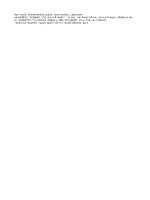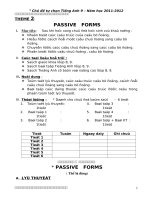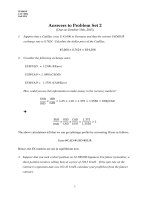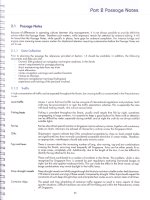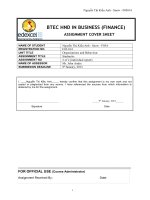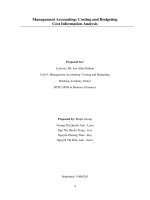1631 assignment 2 (pass)
Bạn đang xem bản rút gọn của tài liệu. Xem và tải ngay bản đầy đủ của tài liệu tại đây (1.16 MB, 38 trang )
Assignment 2 SDLC 1631
ASSIGNMENT 02 FRONT SHEET
Qualification
BTEC Level 5 HND Diploma in Computing
Unit number and title
Unit 09: Software Development Life Cycle
Submission date
Date Received 1st
submission
Re-submission Date
Date Received 2nd
submission
Student Name
Student ID
GCS200222
Đào Vĩnh Khang
Class
GCS0905B
Assessor name
MAI VO
Student declaration
plagiarism. I understand that
I certify that the assignment submission is entirely my own work and I fully understand making a
the consequences of false declaration is a form of malpractice.
Grading grid
Student’s signature
KHANG
P5
P6
P7
M3
Page 2
M4
M5
M6
D3
❒ Summative Feedback:
❒ Resubmission Feedback:
2.1
Grade: Assessor Signature: Date:
Internal Verifier’s Comments:
Signature & Date:
Page 3
Learning Outcomes and Assessment Criteria
Pass
Merit
LO3 Undertake a software development lifecycle
P5 Undertake a software
investigation to meet a
business need.
M3 Analyse how software
requirements can be
traced throughout the
software lifecycle.
P6 Use appropriate
software analysis
tools/techniques to carry
out a software
investigation and create
supporting
documentation.
M4 Discuss two
approaches to improving
software quality.
LO4 Discuss the suitability of software behavioural
design techniques
P7 Explain how user and
software requirements
have been addressed.
M5 Suggest two software
behavioural specification
methods and illustrate
their use with an
example.
M6 Differentiate between
a finite state machines
(FSM) and an extended-
Page 4
Distinction
D3 Critically evaluate
how the use of the
function design paradigm
in the software
development lifecycle can
improve software quality.
D4 Present justifications
of how data driven
software can improve the
reliability and
effectiveness of software.
FSM, providing an
application for both.
TABLE OF CONTENT
I.UNDERTAKE A SOFTWARE INVESTIGATION TO MEET A BUSINESS NEED (P5) .............................................7
1.Stakeholder..................................................................................................................................................7
2.Stakeholders role in Tune Source Project.....................................................................................................8
3.Requirement definition of the project..........................................................................................................9
4.Identify FRs and NFRs of Tune Source Project............................................................................................10
5.Discuss the relationships between the FRS and NFRS.................................................................................11
6.Discuss the technique(s) you would use to obtain the requirements.........................................................11
II.USE APPROPRIATE SOFWARE ANALYSIS TOOLS/TECHNIQUES TP CARRY OUT A SOFTWAREINVESTIGATION
AND CREATE SUPPORTING DOCUMENTATION(P6) .......................................................................................14
1. Requirements modeling…………………………………………………………………………………………………………………………15
2.Flowchart………………………………………………………………………………………………………………………………………………..17
3. Pseudocode……………………………………………………………………………………………………………………………………………19
4.Context Diagram for the whole system. ......................................................................................................20
5.Data Flow Diagram – Level 0 for the whole system ....................................................................................21
6.ERDbfor the whole system. .........................................................................................................................22
III. Explain how user and software requirements have been addressed (P7) ................................................26
1.Use case diagram for the whole
system............................................................................................................................................................28
a. Customer....................................................................................................................................................29
b. Supplier......................................................................................................................................................29
c.Admin..........................................................................................................................................................29
2.Use Case specification for 2 Use cases.......................................................................................................30
a. Use case specific for search function.........................................................................................................30
b. Use Case specification for Purchase Song..................................................................................................31
c. Use Case specification for Download Songs...............................................................................................31
d. Use Case specification for Add Songs ........................................................................................................32
3.Technical solutions......................................................................................................................................32
4.Architecture.................................................................................................................................................33
Page 5
P5.UNDERTAKE A SOFTWARE INVESTIGATION TO MEET A BUSINESS NEED.
1.Stakeholder
A stakeholder is both an individual, organization or employer who's impacted with the aid of using the results
of an assignment or an enterprise venture. They have a hobby withinside the achievement of the assignment
and may be inside or out of doors the employer this is sponsoring the assignment. Stakeholders are very
crucial due to the fact they can have an advantageous or bad impact at the assignment with their decisions.
There also are crucial or key stakeholders, whose help is wanted for the assignment to exist. Identify the
stakeholder, their roles and interest
• Types of Stakeholders
While each undertaking has stakeholders and people stakeholders may be everyone with affect or that may
be inspired with the aid of using the undertaking. We have already visible that there may be many
stakeholders and with a view to be in addition mentioned soon. But all stakeholders may be damaged into
groups: inner stakeholders and outside stakeholders. Let’s check both.
Internal Stakeholders
Internal stakeholders are folks who are inside the corporation. The undertaking at once influences them as
they serve and are hired with the aid of using the corporation coping with it. These can encompass personnel,
owners, the board of directors, undertaking managers, traders and more.
External Stakeholders
External stakeholders are the ones folks who are outdoor of the corporation and are circuitously impacted
with the aid of using the undertaking. They are, however, inspired with the aid of using the corporation’s
paintings however aren't personnel of the corporation. These human beings may be suppliers, customers,
creditors, clients, intermediaries, competitors, society, authorities and more (Landau, 2022).
• Roles of Stakeholders
Direct the Management: The stakeholders may be part of the board of administrators and consequently
assist in taking actions. They can take over sure departments like service, human assets or studies and
improvement and manipulate them for making sure success.
Page 6
They Bring in Money: Stakeholders are the massive buyers of the employer, and they can every time carry
in or take out cash from the employer. Their choice shall depend on the employer’s economic performance.
Therefore, they can pressurize the control for economic reviews and alternate methods if necessary. Some
stakeholders may even boom or lower the funding to alternate the proportion fee withinside the
marketplace and for that reason make the situations favorable for them.
Help in Decision Making: Major stakeholders are a part of the board of administrators. Therefore,
additionally they take selections at the side of different board members. They have the electricity to disrupt
the selections as well. The stakeholders additionally have all the powers to rent senior-degree control.
Therefore, they're there in all the foremost choice-making regions. They additionally take selections
concerning liquidations and additionally acquisitions.
Corporate Conscience: Large stakeholders are the foremost stakeholders of the employer and feature
monitored over all the foremost sports of the employer. They could make the employer abide with the aid
of using human rights and environmental laws. They additionally screen the outsourcing sports and can vote
in opposition to any commercial enterprise choice if it harms the long-time desires of the employer.
Other Responsibilities: Apart from the above 4 foremost roles additionally they have a few different roles
to play with inside the employer. They can discover new regions for marketplace penetration and accelerated
sales. They can carry in extra advertising and marketing thoughts. They additionally entice different buyers
like honeybees withinside the employer. They may be part of a choice board or a consultant for the
employer. Moreover, they can take all the foremost social and environmental selections.
2. Stakeholder’s role in Tune Source Project
Stakeholders
Description
Founders: John Margolis, Megan Owner of Tune Source Company and decisive
Taylor, and Phil, Cooper
significance to the task, besides, offer cash
and possession to the commercial enterprise.
Internal Stakeholders
Project Sponsor: Carly Edwards,
Assistant Vice President,
Marketing.
accountable for the general fulfillment of the
task, along with appointing the task supervisor
and team, defining fulfillment criteria, and
making sure the successful shipping of the
task.
IT department: Programmers,
Designers, Testers, Data Analysts
accountable for supervising the general
device or different responsibilities.
Marketing Department
They are accountable for getting capacity
customers or clients inquisitive about the
Page 7
goods and services. Besides, it may be visible
that they commonly require interplay with the
clicking or different media with the motive is
to make an essential statement or market the
corporation's new product
External
Stakeholders:
Providers: Musician, Singer,
Vendor Big Hit, Entertainment
Providers offer your corporation with track
gadgets and depend on you to generate cash
from the ones sales
Prominent nearby Internet
Service Provider (ISP)
A corporation that offers get entry to the
Internet to each private and commercial
enterprise client.
Customer: Members, Buyers.
Customers need a view to offer and
concentrate on truthful price, and besides, be
inquisitive about shopping organization
products
3/ Requirement definition of the project
Project requirements are situations or duties that ought to be finished to make certain the fulfillment or
finishing touch of the project. They offer a clean photograph of the paintings that wishes to be done. They're
supposed to align the project's sources with the goals of the organization. The blessings of efficiently
collecting project requirements encompass value reduction, better project fulfillment rates, extra powerful
alternate management, and progressed conversation amongst stakeholders.
Project requirements may be classified into 3 predominant categories:
Business requirements are the high-level wishes of the enterprise. They deal with what is required and why
the project is happening. Getting returned to our residence example, an enterprise requirement would
possibly encompass, 'construct an eco-friendly house with high-efficiency sun panels a good way to lessen
carbon emissions and decrease the environmental effect.' This is the place to begin the assignment and gives
steering for the opposite types of requirements. It's vital that those requirements are communicated
certainly and early on.
Solution requirements, which encompass each useful and non-functional requirement, are the capabilities
and traits of the products or services that meet all requirements, of each enterprise, and stakeholder.
Functional requirements describe something that a product or service is needed to do. Non-functional
necessities describe how a gadget is meant to function. A functional requirement in your solar panel is to
'convert mild into power,' at the same time as the non-functional requirement is to 'produce this power at
a performance fee of 20%.
A stakeholder is each person who has a hobby withinside the products or services truly is being produced or
provided. They can be inner stakeholders (employees) or outside stakeholders (customers, regulators, or
Page 8
suppliers). Every man or woman stakeholder has wishes or requirements that they need to be fulfilled. Each
of those wishes ought to be balanced during the path of the project. Oftentimes, stakeholders have
competing wishes, that may affect the schedule, budget, and scope of the assignment if now no longer
controlled efficiently. Suppose because the proprietor of the residence, decides that you need to be
repurposed composite timber for the outside of your residence. However, after your builder has located the
order, you find out that your Homeowners Association's most effective permits for stucco and brick
exteriors. This alternate may have a knock-on impact on phrases of pricing, substances, and layout and could
in the end gradual down the project.
In Tune Source Project:
Business Requirements: Using the Web or in-store kiosks, customers could be capable of looking for and
buying virtual music downloads.
- Search for songs or songs in our virtual song archive.
- Listen to songs or music samples.
- Purchase person downloads at a set rate in keeping with download.
- Establish a client subscription account allowing limitless downloads for a month-to-month rate.
- Purchase song download present cards.
4. Identify FRs and NFRs of Tune Source Project.
Identify FRs and NFRs of Tune Source Project.
A functional requirement defines a gadget or its component. It describes the capabilities a software program
ought to perform. A function is not anything however inputs, its conduct, and outputs. It may be a
calculation, statistics manipulation, enterprise process, consumer interaction, or another precise capability
which defines what feature a gadget is likely to perform. Functional requirements in software program
engineering assist you to seize the meant conduct of the gadget. This conduct can be expressed as
capabilities, offerings or obligations or which gadget is needed to perform.
Functional Requirement (FRs) in Tune Source Project:
- Search Songs
- Login
- Logout
- Register
- Listen to music samples
- Purchase music download gift card
- Download Songs
Page 9
- Add Music to Playlist
A non-functional requirement defines the quality characteristic of a software program gadget. They
constitute a fixed of requirements used to choose the precise operation of a gadget. Example, how rapid
does the internet site load? A nonfunctional requirement is critical to make certain the usability and
effectiveness of the complete software program system. Failing to satisfy non-functional requirements can
bring about structures that fail to meet consumer needs.
Non-Functional Requirements (NFRs) of Tune Source Project:
-Successfully executed
-Quickly search, download
-Have a good security policy
-Best quality sound
-High resolution
-Upload a lot of good songs
- Upload a lot of good songs
5. Discuss the relationships between the FRS and NFRS
Functional Requirements
Non-Functional Requirements
Help understand the functions of the system.
Help understand the performance of the system.
Explain the characteristics that a system is
expected to
have.
Explain the way in which the product should work
(how
it should behave).
Identify what the system must or must not do.
Identify how the system should do it.
Will allow the system to perform, even if the The system will not work with nonnon-functional requirements are not met.
functional
requirements alone.
Ensures the system will meet user
requirements.
Are essential to system operations.
Ensures the product meets user expectations.
Straightforward to define and agree on.
Harder to define and agree on.
Meeting these requirements is obligatory.
Meeting these requirements is not obligatory but
may be desirable.
May be desirable but are not always essential.
Page 10
Define the system or an element of it.
Outline quality attributes of the system.
Usually defined by the user.
Usually defined by software engineers,
developers, software architects or other technical
experts.
Can be documented and understood as a quality
attribute.
Can be documented and understood through a
use case.
6. Discuss the techniques you would use to obtain the requirements.
Interview
This is the most common technique used for requirement elicitation. Interview techniques should be used
for building strong relationships between business analysts and stakeholders. In this technique, the
interviewer directs the question to stakeholders to obtain information. The one-to-one interview is the most
used technique. If the interviewer has a predefined set of questions, then it’s called a structured interview.
If the interviewer is not having any format or any specific questions, then it’s called an unstructured
interview.
For an effective interview, you can consider the 5 Why technique. When you get an answer to all your Whys
then you are done with your interview process. Open-ended questions are used to provide detailed
information. This interviewee cannot say Yes or No only.
Closed questions can be answered in Yes or No form and for areas used to get confirmation on answers.
Basic Rules:
The overall purpose of performing the interviews should be clear.
Identify the interviewees in advance.
Interview goals should be communicated to the interviewee. Interview questions should be prepared before
the interview.
The location of the interview should be predefined.
The time limit should be described.
The interviewer should organize the information and confirm the results with the interviewees as soon as
possible after the interview.
Benefits:
Interactive discussion with stakeholders.
The immediate follow-up to ensure the interviewer’s understanding.
Encourage participation and build relationships by establishing rapport with the stakeholder.
Drawbacks:
Time is required to plan and conduct interviews.
Commitment is required from all the participants.
Page 11
Sometimes training is required to conduct effective interviews.
Joint Application Development (JAD)/ Requirement Workshops
This technique is more process-oriented and formal as compared to other techniques. These are structured
meetings involving end-users, PMs, and SMEs. This is used to define, clarify, and complete requirements.
This technique can be divided into the following categories:
Formal Workshops: These workshops are highly structured and are usually conducted with the selected
group of stakeholders. The focus of this workshop is to define, create, refine, and reach closure on business
requirements.
Business Process Improvement Workshops: These are less formal as compared to the above one. Here,
existing business processes are analyzed, and process improvements are identified.
Benefits:
•
•
•
•
Documentation is completed within hours and is provided quickly back to participants for review.
You can get on-the-spot confirmation on requirements.
Successfully gathered requirements from a large group in a short period.
Consensus can be achieved as issues and questions are asked in the presence of all the stakeholders.
Drawbacks:
•
•
•
Stakeholders’ availability might ruin the session.
The success rate depends on the expertise of the facilitator.
A workshop motive cannot be achieved if there are too many participants.
Questionnaire
A questionnaire is a research tool featuring a series of questions used to collect useful information from
respondents. These instruments include either written or oral questions and comprise an interview-style
format. Questionnaires may be qualitative or quantitative and can be conducted online, by phone, on paper
or face-to-face, and questions don’t necessarily have to be administered with a researcher present.
Page 12
Advantages of Questionnaires
Some of the many benefits of using questionnaires as a research tool include:
•
•
•
•
•
•
•
•
Practicality: Questionnaires enable researchers to strategically manage their target audience,
questions, and format while gathering large data quantities on any subject.
Cost-efficiency: You don’t need to hire surveyors to deliver your survey questions — instead, you can
place them on your website or email them to respondents at little to no cost.
Speed: You can gather survey results quickly and effortlessly using mobile tools, obtaining responses
and insights in 24 hours or less.
Comparability: Researchers can use the same questionnaire yearly and compare research results to
gain valuable insights and minimize translation errors.
Scalability: Questionnaires are highly scalable, allowing researchers to distribute them to
demographics anywhere across the globe.
Standardization: You can standardize your questionnaire with as many questions as you want about
any topic.
Respondent comfort: When taking a questionnaire, respondents are completely anonymous and not
subject to stressful time constraints, helping them feel relaxed and encouraging them to provide
truthful responses.
Easy analysis: Questionnaires often have built-in tools that automate analyses, making it fast and
easy to interpret your results.
Disadvantages of Questionnaires
Page 13
Questionnaires also have their disadvantages, such as:
•
•
•
•
•
•
Answer dishonesty: Respondents may not always be completely truthful with their answers — some
may have hidden agendas, while others may answer how they think society would deem most
acceptable.
Question skipping: Make sure to require answers for all your survey questions. Otherwise, you may
run the risk of respondents leaving questions unanswered.
Interpretation difficulties: If a question isn’t straightforward enough, respondents may struggle to
interpret it accurately. That’s why it’s essential to state questions clearly and concisely, with
explanations when necessary.
Survey fatigue: Respondents may experience survey fatigue if they receive too many surveys, or a
questionnaire is too long.
Analysis challenges: Though closed questions are easy to analyze, open questions require a human
to review and interpret them. Try limiting open-ended questions in your survey to gain more
quantifiable data you can evaluate and utilize more quickly.
Unconscientious responses: If respondents don’t read your questions thoroughly or entirely, they
may offer inaccurate answers that can impact data validity. You can minimize this risk by making
questions as short and straightforward as possible.
Document analysis
Document analysis helps researchers understand and categorize primary sources or original accounts from
people who had personal experience with the topic. When developing their studies, researchers use
established sources to gather ideas and evidence to support their claims. This process allows researchers to
evaluate the quality and purpose of the documents they use to determine if the information they contain
will benefit their studies. In this article, we discuss what document analysis is, how to perform document
analysis and the steps researchers take in completing this process.
Page 14
The Advantages of Document Analysis:
•
•
document analysis is an efficient and effective way of gathering data because documents are
manageable and practical resources. Documents are commonplace and come in a variety of forms,
making documents a very accessible and reliable source of data.
Document analysis is often used because of the many ways it can support and strengthen research.
Document analysis can be used in many different fields of research, as either a primary method of
data collection or as a complement to other methods.
The Disadvantages of Document Analysis:
•
•
•
The disadvantages are the bias stemming from the fact that the document was written for some
other purposes (primarily for making money) rather than social research.
Thus, the documents tend to be exaggerated and often fabricated to make a good story.
Some documents are generally written on paper, and they do not withstand the elements well unless
care is taken to preserve them. Many documents are incomplete and un-standardized, and thus
researchers encounter difficulties in coding and analysis.
Observation
Observation, as the name implies, is a way of collecting data through observing. This data collection method
is classified as a participatory study because the researcher must immerse herself in the setting where her
Page 15
respondents are while taking notes and/or recording. The observation data collection method may involve
watching, listening, reading, touching, and recording behavior and characteristics of phenomena.
Observation as a data collection method can be structured or unstructured. In structured or systematic
observation, data collection is conducted using specific variables and according to a pre-defined schedule.
Unstructured observation, on the other hand, is conducted in an open and free manner in the sense that
there would be no pre-determined variables or objectives.
Advantages of the observation data collection method include direct access to research phenomena, high
levels of flexibility in terms of application, and generating a permanent record of phenomena to be referred
to later. At the same time, this method is disadvantaged by longer time requirements, high levels of observer
bias, and the impact of the observer on primary data, in a way that the presence of an observer may influence
the behavior of sample group elements.
It is important to note that the observation data collection method may be associated with certain ethical
issues. As it is discussed further below in greater detail, fully informed consent of research participant(s) is
one of the basic ethical considerations to be adhered to by researchers. At the same time, the behavior of
Page 16
sample group members may change with negative implications on the level of research validity if they are
notified about the presence of the observer.
Apply to Tune Source project
For me, I choose interview techniques
Name
Mark Goodin
Position
Purpose of interview
Manager, Accounts, Payable
Meeting
Current problem with
Mon, March 1
accounts payable process,
4:00-5:15 P.M
future processes
Anne Asher
Supervisor, Data Entry
Accounts receivable and
Wed, March 3
payable processes
10:00-11:00 A.M
Mark Goodin: He build an information about future job for candidates. He prepares a few questions for
candidates to answer them.
Anne Asher: As the interview progresses, Anne demonstrates very little practical experience working with
student data and registration. We realized Anne would be most suited to a position as an Enrollment
Records Associate’s assistant. We are not interested in making Anne an often for this question.
Some interviews note:
Person interviewer: Mark Goodin ( Manager, Accounts, Payable)
Interviewer: Barbara Wixom
Purpose of interview:
•
understand reports produced for human resources by the current system.
•
Determine information requirements for future systems.
Summary of interview:
•
Sample reports of all current HR reports are attached to these reports. The information that is not
used and missing information are noted on the reports.
•
Two biggest problems with the current system are:
1.The data is too old.
2.The data is of poor quality.
•
The most common data errors found in the current system include incorrect job-level information
and missing salary information.
Page 17
Open items:
•
Get current employee roster report form Mary Skudrna (extension 4355)
•
Verify calculations used to determine vacation time with Mary Skudrna.
•
Schedule interview with Jim Wack (extension 2337) regarding the reasons for data quality
problems.
Detailed Notes: See attached transcript.
Person interviewer: Anne Asher (Supervisor, Data Entry)
Interviewer: Barbara Wixom
Purpose of interview:
•
understand reports produced for human resources by the current system.
•
Determine information requirements for future systems.
Summary of interview:
•
Sample reports of all current HR reports are attached to these reports. The information that is not
used and missing information are noted on the reports.
•
Two biggest problems with the current system are:
1.The data is too old.
2.The data is of poor quality.
•
The most common data errors found in the current system include incorrect job-level information
and missing salary information.
Open items:
•
Get current employee roster report form Mary Skudrna (extension 4355)
•
Verify calculations used to determine vacation time with Mary Skudrna.
•
Schedule interview with Jim Wack (extension 2337) regarding the reasons for data quality
problems.
Detailed Notes: See attached transcript.
P6. USE APPROPRIATE SOFWARE ANALYSIS TOOLS/TECHNIQUES TP CARRY OUT A
SOFTWARE INVESTIGATION AND CREATE SUPPORTING DOCUMENTATION
1/ Requirements modeling
Page 18
Requirements modeling is the process used in software development projects where requirements and
solutions constantly evolve through collaborative efforts and teamwork. By using this method of crossfunctional and self-organizing teams, you can ensure that your team meets the exact needs of the
stakeholders.
2/ Flowchart
Founders Of Tune Source: John Margolis, Megan Taylor, and Phil Cooper
Project Sponsor: Carly Edwards, Assistant Vice President, Marketing.
Project Manager: Tran Thai Hoa
2.1/ Login/ Register
Page 19
Page 20
2.2/ Search song
3/ Pseudocode
Page 21
Page 22
4/ Context Diagram for the whole system
Page 23
Description: The Context Diagrams clearly represent the system under consideration as a single high-level
process, followed by the system's connection with other external entities (such as systems, organizational
groups, external data stores, and so on).
5/ Data Flow Diagram – Level 0 for the whole system
Description: A data flow diagram depicts the movement of data through a system or process. It includes data
inputs and outputs, data repositories, and the subprocesses that the data flows through. DFDs employ
standardized symbols and notation to define various entities and their connections.
6/ ERD for the whole system.
Page 24
Entity
Description
Customer
Customers' information is stored in the system's consumers.
Promotion
Including Promotional information
Order
Including the specific information of the customer's order
Order Detail
Including the specific information of the order detail
Song
Contains information on songs that customers listen to the song and order it
Album
Album Information for the Song
Musician
Contains Musician’s information
Category
Including Category’s information
Gift card
Contains Gift card’s detail
Customer Entity
No
Name
1
CustomerID
Data Type
Int
Relationship
Primary key
Page 25

